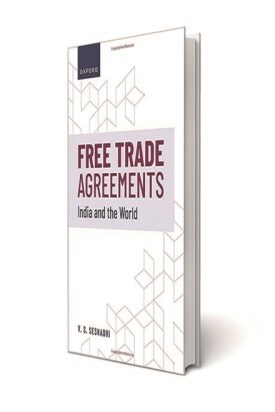By JS Deepak
Two mega-regional trade deals—the signing of the RCEP agreement by 15 countries of the Asia-Pacific (accounting for 30% of global trade) in late 2020 and the launch of the African Continental Free Trade Area (comprising 54 countries and an economy of $1.7 trillion) in January 2021— have revived the narrative on free trade agreements or FTAs.
Notwithstanding the fact that India decided to stay out of RCEP to protect its domestic industry, the role that FTAs can play in enhancing trade and making this growth engine fire for us is again at the centre of attention. The Modi government, which came to power on an anti-FTA plank, seems to have been forced into a re-think. A comprehensive book on FTAs, underlining their genesis and role in India’s economic development is, therefore, timely.
Also read: Dry, itchy, infuriating scalp? Here’s how you can fix it!
Ambassador VS Seshadri has meticulously documented various aspects of this instrument of economic partnership. He has admirable credentials for the job. From having been a diplomat dealing with trade and investment issues, to an Indian trade negotiator and an academic studying the elements and impacts of FTAs, he has worn many hats. This has helped him develop extraordinary expertise and incisive opinions on bilateral trade agreements, so evident in the book, which can serve both as a compendium on the subject for students of economics and trade policy, as well as a reference manual for those with a deeper interest.

Going through the book, I found it brilliant and erudite. It conveys its message on a serious public policy issue through a lucid narrative, peppered with interesting ideas and insightful surmises. I was also impressed by its comprehensiveness; the way it combines a wide sweep of the subject, covering topics related to FTAs both from international and Indian perspectives with amazing depth. Remarkable in its rigour, the extent of research and scholarship is clearly evident from the long list of pertinent references at the end of each chapter. IT czar Narayana Murthy once famously stated: “In God we trust, everyone else needs to bring data to the table.” The book clearly meets this benchmark as its conclusions are mostly evidence based.
The evolution of FTAs over the years from simple tariff reduction initiatives to complex agreements on goods, services and rules following the collapse of the Doha Round of negotiations at the WTO is well brought out. It takes us through the growth of FTAs from a smattering of individual pacts to a spaghetti bowl of interconnected arrangements with overlaps and linkages. The chapters on CPTPP and the Korean strategy lay out learnings from global experience. But the parts I found most interesting were the ones related to India’s FTA journey that are both descriptive and prescriptive. The analysis of what worked and what could have been done differently, the conclusions the author draws from RCEP negotiations and the evaluation of the recent FTAs are really valuable.
Also read: How the multiverse has failed to give marvel phase 4 superheroes its Marvel-ness
Ambassador Seshadri also examines the question whether India has benefited from the FTAs it has signed in some detail, outlining the pluses and minuses of each agreement. In doing so, he does not confine himself to a single metric, the trade deficit, as is often done, but looks at a variety of indicators, including the growth in overall exports, market access in goods, liberalisation of services trade, other factors like investment promotion and the overall impact. The author also makes a very valid observation that FTAs are about give and take. Deep market access in areas of our interest is possible if we are willing to give up some sectors. Borrowing a chess analogy, one can protect the king, the queen and the knight, but must sacrifice some pawns. And this requires wide consultation among stakeholders and development of a consensus on must-haves and red lines in negotiations, which is often so challenging.
Despite its obvious merit, the book does fall short on a few counts. While offering a detailed overview of India’s experience with FTAs, it overlooks the fact that we have done little to use FTAs in promoting regional economic integration, something which many like the EU and US have excelled at. The overhang of politics over economics and the way geopolitics trumps trade interests every time in south Asia appears to be the culprit here.
Ambassador Seshadri, with his rich diplomatic experience, could have offered pragmatic suggestions to remedy this situation.
Again, the book acknowledges that investments ride on trade and recognises the role of CECAs in helping enhance investments. It notes that investments from companies in Singapore, Korea and Japan, with whom we have comprehensive trade and investment agreements, may not have been at the same level in the absence of investment protection measures in the FTAs. However, it fails to point out unequivocally that being a demandeur of foreign investment and without a credible bilateral investment protection agreement with any large economy, India needs comprehensive trade and investment partnerships going forward. Something that is glaringly absent in our recent FTAs with UAE and Australia!
The book makes a host of valuable recommendations for our future FTA strategy but refrains from suggesting a negative list of countries to avoid FTA engagements with till we have put our house in order through reforms and built capacity. Our experience of the China challenge in RCEP and the gold standard rules on digital trade, labour, environment and IPRs being demanded by the US, both of which find a place in the book, point to the difficulty in starting FTA negotiations with these big boys. Inclusion of these elements might have further raised the already high bar that this very readable subject classic brought out by the Oxford University Press sets.
Free Trade Agreements: India and the World
VS Seshadri
Oxford University Press
Pp 384, Rs 1,495
JS Deepak is a retired IAS Officer who served as secretary IT, telecom, GoI, and ambassador of India to the WTO. Views are personal







